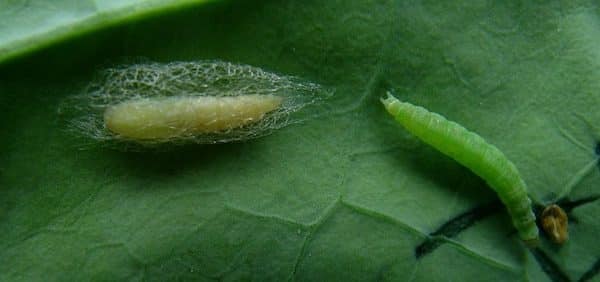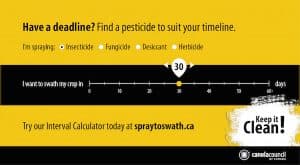Diamondback moth larvae have been found in canola fields across the Prairies this year. Of those fields with the larvae, counts in many (perhaps most) are below and often well below thresholds. Some fields are at thresholds. Some fields seem to be well above thresholds. The key is to the check each field. Diamondback larvae can vary in number from field to field and even within areas of a field.
At $15 to $25 per acre to spray — depending on product and application method – knowing where a spray will pay and where it won’t is an important economic consideration. With swathing close in some areas, pay close attention to product pre-harvest intervals.
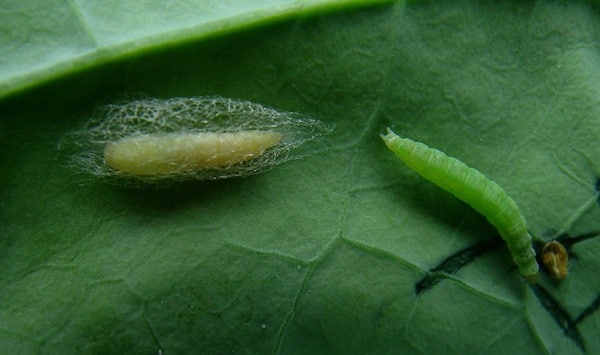
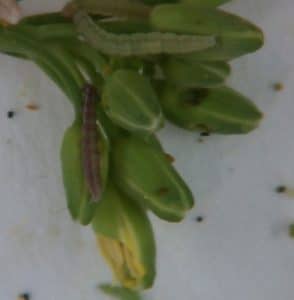
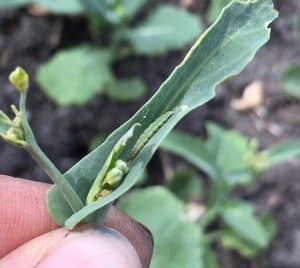
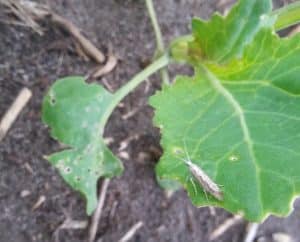
Here are answers to common questions:
Why are we seeing so many larvae this year? There are three main reasons. (1) Early arrival. The earlier the adults arrive on winds from the south, where they overwinter, the more cycles they can have during the growing season. With early arrival this year, diamondback moths could go through three life cycles (and possibly four), although these late generations can be significantly reduced by parasitism. The Prairie Pest Monitoring Network reports that a third generation is likely underway as of July 31. (2) Heat. Diamondback moth respond to the heat with quick generational development. We’ve also reported that the key parasitoid (diadegma) doesn’t like hot weather. (3) Dry weather has kept fungal infection of eggs to a minimum. With a high percentage of eggs surviving, each life cycle will produce more and more worms. The dry conditions have also meant that there is a lack of heavy rains to knock larva off the plant and wash them to the ground where beetles and other beneficials can eat them. Heavy rainfall can be a major mortality factor for eggs and early instars of diamondback moth.
Why didn’t adult trap counts raise any major alarms? During the adult trap period of early May to late June, adult numbers were within normal ranges — although cumulative trap counts did increase substantially in the last week or two of trap season.
Will we have another generation this year? It is possible. Diamondback moths can go through 3 or 4 generations in Western Canada, and the PPMN blog from late July indicated that a third generation could be hatching. Often by the time the third generation comes along, beneficial fungal infections or insect populations have also built up to keep diamondback moth numbers below thresholds. But check just in case. While these beneficials have been reliable over the past decade or so, hot and dry conditions this year seem to favour the pest over the beneficials.
What do diamondback larvae look like? The larvae are pale yellowish-green to green and covered with fine, scattered, erect hairs (that you’d need a hand lens to see). The posterior end of the caterpillar is forked, which is easy to see with the naked eye. At maturity, larvae are cigar-shaped or spindle-shaped (narrower at each end) and about 12mm (0.5″) long. First instars are very small (~1mm) and feed between leaf surfaces. You will often find all sizes present. When disturbed, larvae will wriggle backward violently and may drop from the plant, suspended by a silken thread. (Note: The silken thread is not unique to diamondback larvae.) After several seconds, larvae will climb back onto the leaf and continue feeding.
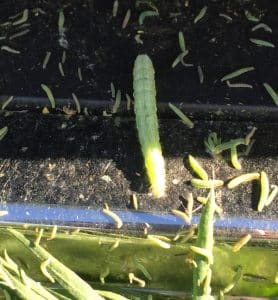
What is the threshold? As canola leaves senesce, diamondback larvae usually move up to the pods. Feeding on the exterior of the developing pods is responsible for their “economic” pest status. The nominal threshold for diamondback moth larvae is 200-300 larvae per square metre (20-30 per square foot) in plants with flowers and pods. Plants under moisture stress and with very little leaf surface may be more likely to suffer yield loss, so the lower threshold number could be used in this situation.
How do I count them? To do a proper count, pull out all plants within a quarter of a square metre OR one square foot then knock all plants on a drop-cloth or large piece of cardboard. (Working as close to the scouting site will prevent larvae from dropping off on the way to the truck.) Count the larvae. If you can identify them as diamondback larvae, count them. Squishing larvae as you count them makes it easier to keep an accurate count. Also count the number that fell to the ground within the square. For counts within a quarter square metre (50cm by 50cm square), multiply by 4 to get the number per square metre. For counts within a square foot, multiply by 10 to get the number per square metre. (Note: Not all entomologists agree that extrapolating based on counts from one square foot is appropriate, arguing that the nominal threshold is based on larvae per square metre.)
Sample a few areas of the field. Note that looking at individual plants only will not give an accurate impression of risk, especially if the plants selected are only those that have obvious signs of larvae damage. Thresholds require a more random approach, which is what you get by sampling all plants within a quarter square metre and checking several different sites.
–On sweep net counts: Diamondback larvae thresholds are NOT based on sweep net counts. Sweep net sampling can determine the presence and general abundance of the species in the field, but does not provide a good estimate of larval density because no correlative studies have been conducted to relate sweep net captures with density. Finding them in sweep nets can prompt producers to perform proper counts. Keep in mind that sweep netting only targets the flower and pod area. As a result, it could lead to false negatives if most larvae are lower in the canopy.
Where are they feeding? First instars feed within the upper and lower membrane of the canola leaf, producing a window-pane effect where only the clear outer membranes are left. As larvae grow, they will start eating through leaves. If larvae are numerous, they may eat the entire leaf, leaving only the veins. Larval feeding damage to canola leaves is usually considered to have a minor effect on yield, but as they eat through the leaves, larvae will feed on buds, flowers and pods. This is more damaging to yield, especially when plants are under abiotic stress (e.g., drought) and cannot compensate by producing new buds and flowers. Note that if most larvae are feeding on leaves, they may not be well-controlled by a spray. Higher water volumes can help sprays penetrate the canopy.
How much can they possibly eat? At high numbers and with enough time, they can cause heavy yield loss.
Do diamondback larvae stop feeding when pods start to firm up and senesce? Diamondbacks will continue to feed on green tissue. Rather than starve, they will continue to strip pods and eat leaves as long as there is some moisture in them. As pods start to harden off, the damage will shift to the younger top pods.
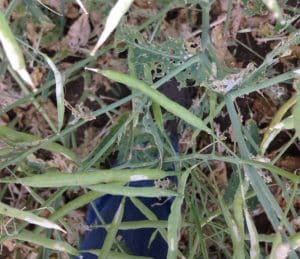
Will damaged pods yield anything? When plants are fully podded and leaves begin to wilt or die in late July or early August, larvae will start to remove the surface tissue from the stems and pods. Seeds within a damaged pod will not fill completely and pods may shatter, resulting in yield loss. Continued heat combined with extensive feeding on the exterior of canola pods will render the pods fragile. A variety with pod-shatter tolerance may be less likely to shatter if pods are chewed. (We say “may be” because we don’t really know.)
Can larvae keep eating after the crop is swathed? It can take several days for the centre of a swath to dry, during which time the larvae will continue to eat. However, no sprays are registered for swathed crop. Do not spray swathed crop as this represents a high residue risk. Always follow pre-harvest intervals. See the next question.
What are the pre-harvest intervals for insecticides? A lot of crop is close to swathing. That greatly limits the product options available to control insects that are above thresholds at this stage of the season. Use the “Have a Deadline?” tool at spraytoswath.ca to select how many days to cutting. This will provide the list of products allowed to be applied within that window.
Will a spray pay for low-yielding canola? At $15 to $25 per acre to spray – depending on product and application method – a spray that saves 2-3 bu./ac. should be at or slightly above the economic threshold. Larvae at thresholds and eating on pods will be able to reduce yields by that much or more. But, importantly, if yield potential for all canola on a farm is well under its crop insurance coverage point, spending more on the crop doesn’t make financial sense.
What spraying conditions are recommended? Higher water volumes are recommended for contact products that require coverage, especially if most of the larvae are on leaves lower in the canopy. One general recommendation is to avoid excessive heat. The Decis label specifically says do not spray at temperatures above 25°C. We’ve had many days well above 25°C lately. Spraying later in the day when it’s cooler may help. (This is not an issue for all products. Coragen, for example, can be applied in cool and hot conditions.) If the field still has flowers, spraying as late in the day as practical will minimize harm to pollinators and will not compromise control of diamondback moth. Read the labels on second applications and pre-harvest intervals. Some products can only be sprayed once per year on a canola crop. And with crop advancing quickly, pre-harvest intervals (which prevent residues on harvested seed) are an important factor. Find PHIs for all products at spraytoswath.ca.
What effect can rain have on diamondback larvae numbers? Driving rain can knock them off and they can drown in pools of water on the ground. Moisture can bring fungal infection that can kill off some of the larvae and prevent next-generation eggs from hatching. Moisture can also help the crop with pod fill and, if still flowering, can extend the flower and help it compensate for earlier insect feeding. After a rain, definitely re-scout. If thresholds before rain were close to action, they may not be after the rain.
Further reading:
Diamondback moth lifecycle diagram. See figure 5 in this NDSU document.
Prairie Soils & Crops Journal: The Diamondback Moth in Canola and Mustard
Canola Encyclopedia chapter on diamondback moth
Chemical control options: Canola Encyclopedia
Diamondback survey results in Alberta
PPMN website info on diamondback moth

